Test of Dancing Waters
| The Test of Dancing Waters |
|---|
| (Test - Art and Music) |
| Other Requirements |
| Verification |
|
|
Build wonderfully complex animated fountains of water. As the basins fill and empty, beautiful patterns will form.
Test Description
You sign up for the Test of Dancing Waters and learn to build complex mechanical fountains.
Task
Build a Fountain, a beautiful and dynamic display of water. You have the option of tearing down your Fountain early, skipping the Judging steps.
- Build a Dancing Waters Mechanism(1 TP)
- Start the Mechanism, achieving at least 20% Mechanical Stress(1 TP)
- Tear down your Fountain, OR do the following:
- Have Seven Judges rate your Fountain
- Design rated Good by most judges(1 TP)
- Pass the Test of Dancing Waters
Additional Information
Design an elegant water fountain using a variety of basins, nozzles and creative timing of effects.
First, build a Dancing Waters Mechanism, using a Small Construction Site. Then you can build basins nearby the Mechanism and install nozzles (which can be forged out of different metals) in the basins. Then the fun begins...
Dancing Waters Mechanism
Built in a Small Construction Site.
- 200 Cut Stones to lower water table
- 100 Concrete for basic mechanism
- 40 Glass Pipes for delicate control
- 2 Copper Pipes for main inflow and outflow
- 1 random 3-output gearbox
Note: The Mechanism can not be too close to another one (40 coords away has been confirmed to be a safe distance), as it will not let you access it. Make sure that you scout the entire area before building as ground clutter will prevent other fountains showing on your screen.
Installation Notes
Fountain mechanisms may not be built too close to other players' fountains. If you do, you'll receive a message that "The fountain's delicate machinery is not working, due to the vibrations of nearby fountain controllers."
There are a number of guides on the wiki (T6 and older) that explain the basics of how to make and work a fountain.
One item missing in these descriptions is "How to solve leaks". Leaks are marked by large bright blue circles on the interface.
Leaks come in several forms.
- Hosepipe Leak:
The most common is from a nozzle that points out of it's basin to another location but doesn't truly hit the other basin. The dots marking your location (yellow) and a tiny gray dot marks where the water is really going. There is about 5 or 10 ft difference. Just re-aim the nozzle by moving the yellow dot and it's gray shadow until the gray shadow is inside the target basin.
- Well is Dry Leak:
A draining basin may or may not be caused by a leak as it can also be caused by more water flowing out than flowing in to the basin. If you watch the numbers on the interface that represent the water level as you test, if you see the numbers in any basin always going down, that means you are pushing out more water from your nozzles than the basin is receiving from another source. Either change the nozzle to something that pumps less water or have another fountain nozzle target that basin. You can also change the aim of a nozzle to "circle" the basin, where the gray dot is just inside the basin icon, but the actually animated spray will splash outside of the basin. Per other guides: either 50% of the water is re-captured or 100% is re-captured.
- Wind Carry Leak:
Another leak can show up if the basins are too far apart. While you can place them far way and the nozzle will target the basin correctly, you will see mysterious leak circles on the interface. You can move the basins closer together to clear up those leaks. You can also insert another basin in between them to "catch the water" passing over it.
- Mechanism Stalled:
While not a leak, when this happens the fountain won't start at all. If the mechanism exceeds 99% (100%) it won't start. The easy fix for this is to reduce the flow of water from the nozzles. That means: Change to a different type of nozzle that uses less water. Another option is to add an interval with no action in the sequence for any nozzle. This spacer reduces the stress on the mechanism. Changing the nozzle has more direct reduction, adding a spacer has less but can be the difference between starting and not starting.
Basins
Each basin is built in a separate Small Construction Site.
| Size | Copper Pipe | Cut Stone | Mandibular Glue | Diameter | Image |
|---|---|---|---|---|---|
| Small | 10 | 30 | 15 | 8 ft. (0.5 coords) | 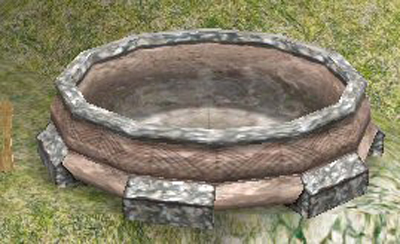
|
| Medium | 20 | 60 | 30 | 12 ft. (0.75 coords) | 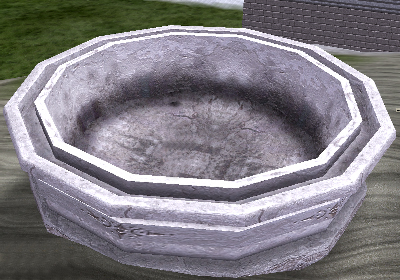
|
| Large | 30 | 90 | 45 | 16 ft. (1 coord) | 
|
| Huge | 40 | 120 | 60 | 20 ft. (1.25 coords) | 
|
Nozzles
Nozzles are made in a Master's Casting Box.
| Name | Metal | Beeswax | Minutes | Ave. Flow Rate | Image |
|---|---|---|---|---|---|
| Crystal Fog | 1 Brass | 1 | 10 | 1.75 | 
|
| Dirty Rain | 1 Copper | 1 | 10 | 9.24 | 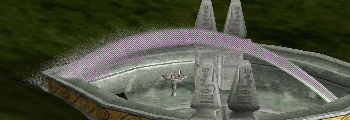
|
| Foggy Shower | 1 Copper | 1 | 10 | 3.52 | 
|
| Light Rain | 1 Bronze | 1 | 20 | 3.50 | 
|
| Misty Bubbles | 1 Brass | 1 | 5 (10 min in SCB) | 1.07 | 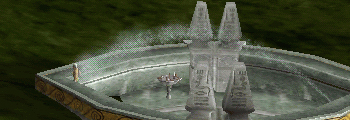
|
| White Shower | 4 Brass | 4 | 30 | 2.45 | 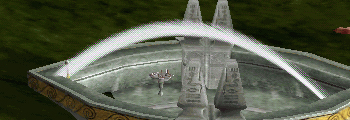
|
Locations
| Region | Coordinates | Designer | Notes | Passed |
|---|---|---|---|---|
| Red Sea | 2032, 1991 | Brucette | One Basin Wonder | |
| Bernike | 3097, -686 | cathy | ||
| Bernike | 3006, -913 | Nissim | Passed | |
| Red Sea | 1935, 2086 | Al-Bilal | ||
| Upper Egypt | 932, -1799 | Jyin | ||
| Upper Egypt | 854, -1729 | Stoiss | ||
| Upper Egypt | 1058, -2269 | Shiva | Passed | |
| Tanis | 1158,7014 | Murtha | ||
| Red Sea | 1805, 1970 | Styx | Passed | |
| Red Sea | 1802, 1928 | Dawner |
Demonstration
To demonstrate, you need to have learned Gearbox Design
You must also present:
- 1 Concrete
- 1 Glass Pipe
- 1 Copper Pipe
- 1 Mandibular Glue